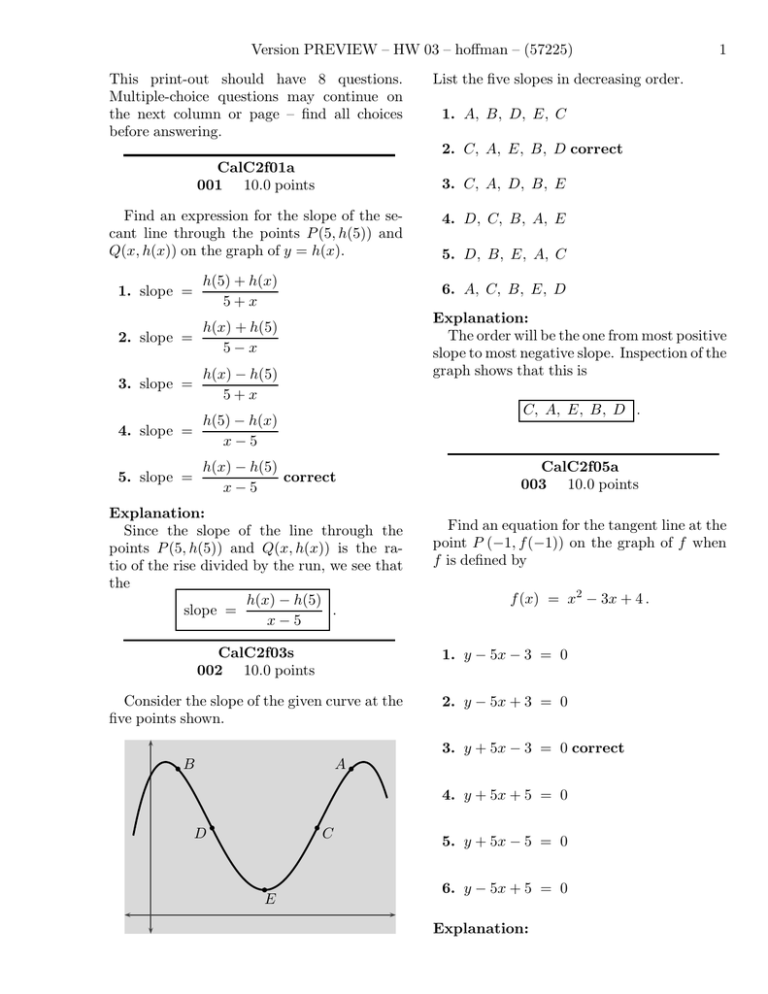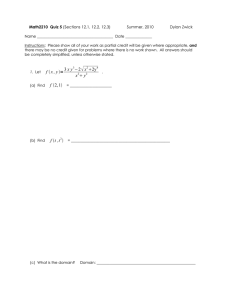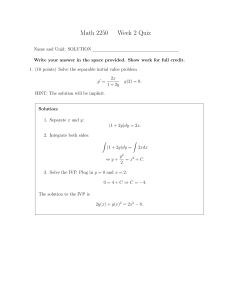Version PREVIEW – HW 03 – hoffman – (57225) 1 This print
advertisement

Version PREVIEW – HW 03 – hoffman – (57225)
This print-out should have 8 questions.
Multiple-choice questions may continue on
the next column or page – find all choices
before answering.
1
List the five slopes in decreasing order.
1. A, B, D, E, C
2. C, A, E, B, D correct
CalC2f01a
001 10.0 points
3. C, A, D, B, E
Find an expression for the slope of the secant line through the points P (5, h(5)) and
Q(x, h(x)) on the graph of y = h(x).
h(5) + h(x)
5+x
1. slope =
Explanation:
The order will be the one from most positive
slope to most negative slope. Inspection of the
graph shows that this is
h(x) − h(5)
5+x
C, A, E, B, D .
h(5) − h(x)
4. slope =
x−5
h(x) − h(5)
correct
x−5
5. slope =
5. D, B, E, A, C
6. A, C, B, E, D
h(x) + h(5)
2. slope =
5−x
3. slope =
4. D, C, B, A, E
Explanation:
Since the slope of the line through the
points P (5, h(5)) and Q(x, h(x)) is the ratio of the rise divided by the run, we see that
the
h(x) − h(5)
slope =
.
x−5
CalC2f05a
003 10.0 points
Find an equation for the tangent line at the
point P (−1, f (−1)) on the graph of f when
f is defined by
f (x) = x2 − 3x + 4 .
CalC2f03s
002 10.0 points
1. y − 5x − 3 = 0
Consider the slope of the given curve at the
five points shown.
2. y − 5x + 3 = 0
B
A
3. y + 5x − 3 = 0 correct
4. y + 5x + 5 = 0
C
D
E
5. y + 5x − 5 = 0
6. y − 5x + 5 = 0
Explanation:
Version PREVIEW – HW 03 – hoffman – (57225)
The slope of the tangent line
P (−1, f (−1)) is the value of the limit
at
f (−1 + h) − f (−1)
.
h
h→0
lim
2
What is her speed after 9 minutes, and in
what direction is she heading at that time?
1. away from RLM at 20 yds/min.
Now
2. towards RLM at 25 yds/min. correct
f (−1 + h)
= (−1 + h)2 − 3(−1 + h) + 4
3. away from RLM at 30 yds/min.
2
= h − 5h + 8 ,
4. towards RLM at 30 yds/min.
while f (−1) = 8. Thus
f (−1 + h) − f (−1)
h
5. towards RLM at 20 yds/min.
h2 − 5h
= h− 5.
h
As h approaches 0, therefore,
=
f (−1 + h) − f (−1)
→ −3 .
h
Consequently, by the point-slope formula, an
equation for the tangent line at P (−1, f (−1))
is
y − 8 = −5(x + 1) ,
i.e.,
y + 5x − 3 = 0 .
6. away from RLM at 25 yds/min.
Explanation:
The graph is linear on [8, 10], so the student’s speed at time t = 9 is the (absolute
value of the) slope of this line. Hence
slope =
100 − 150
= −25 .
10 − 8
The fact that her distance from RLM is decreasing at t = 9 indicates that she is walking
towards RLM at that time.
CalC2f15c
004 10.0 points
A Calculus student leaves the RLM building and walks in a straight line to the PCL
Library. Her distance from RLM after t minutes is given by the graph
CalC3a00Ex2
005 10.0 points
If P (a, f (a)) is the point on the graph of
f (x) = 3x2 + 2x + 1
yards
500
at which the tangent line is parallel to the line
400
y = 6x + 2 ,
300
determine a.
200
100
2
4
6
8
10
mins
12
1. a =
1
6
2. a =
1
2
Version PREVIEW – HW 03 – hoffman – (57225)
f (x) − f (a)
x→a
x−a
f (x + h) − f (x)
III. lim
x→a
h
II. lim
2
3. a =
correct
3
4. a =
3
1
3
1. II only
5. a = 0
2. I and II only correct
Explanation:
The slope of the tangent line at the point
P (a, f (a)) on the graph of f is the value
f (a + h) − f (a)
f ′ (a) = lim
h→0
h
of the derivative of f at x = a. To compute
the value of f ′ (a), note that
3. I only
4. I and III only
5. I, II, and III
Explanation:
Both of
f (a + h) = 3(a + h)2 + 2(a + h) + 1
2
f ′ (a) = lim
h→0
2
= 3a + h(6a + 2) + 3h + 2a + 1 ,
f (a + h) − f (a)
h
and
while
f ′ (a) = lim
2
f (a) = 3a + 2a + 1 .
x→a
f (x) − f (a)
x−a
are valid definitions of f ′ (a). By contrast,
Thus
f (a + h) − f (a) = h{(6a + 2) + 3h} ,
in which case
f ′ (a) = lim {(6a + 2) + 3h} = 6a + 2 .
h→0
lim
x→a
f (a + h) − f (a)
f (x + h) − f (x)
=
h
h
because f is continuous. Consequently, f ′ (a)
is given only by
If the tangent line at P is parallel to the line
I and II
.
y = 6x + 2 ,
then they have the same slopes, so
CalC3a05
007 10.0 points
f ′ (a) = 6a + 2 = 6 .
If f is a differentiable function, find the
value of the limit
Consequently,
a =
2
.
3
CalC3a01a
006 10.0 points
If f is a differentiable function, then f ′ (a)
is given by which of the following?
I. lim
h→0
f (a + h) − f (a)
h
lim
h→0
5f (x + h) − 5f (x − h)
.
h
1. limit doesn’t exist
2. limit = 5f ′ (x)
3. limit = 10f ′ (x) correct
Version PREVIEW – HW 03 – hoffman – (57225)
Explanation:
By definition
4. limit = 0
f ′ (a) = lim
5. limit = −10f ′ (x)
h→0
Explanation:
Since f is differentiable,
f (x + h) − f (x)
f (x) = lim
h→0
h
′
f (x) − f (x − h)
= lim
.
h
h→0
But then
5f (x + h) − 5f (x − h)
h
h→0
n f (x + h) − f (x)
= 5 lim
h
h→0
f (x) − f (x − h) o
,
+
h
lim
and so by the properties of limits,
limit = 10f ′ (x).
CalC3a20s
008 10.0 points
For what function f and number a is the
limit
√
4+h−2
lim
h
h→0
the value of f ′ (a)?
1. f (x) = x2 ,
a =
1
4
1
,
x
a = 2
3. f (x) = x,
a = 2
2. f (x) =
4. f (x) = x1/2 ,
a = 2
5. f (x) = x1/2 ,
a = 4 correct
6. f (x) =
1
,
x2
4
a = 4
f (a + h) − f (a)
.
h
When
f (a + h) − f (a)
=
h
√
4+h−2
,
h
therefore, inspection shows that
f (x) = x1/2 ,
a = 4 .


